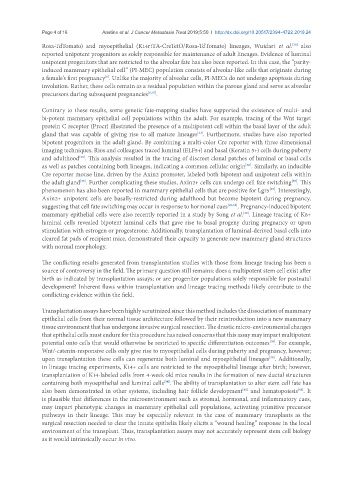Page 359 - Read Online
P. 359
Page 4 of 16 Anstine et al. J Cancer Metastasis Treat 2019;5:50 I http://dx.doi.org/10.20517/2394-4722.2019.24
Rosa-TdTomato) and myoepithelial (K14rtTA-CreTetO/Rosa-TdTomato) lineages, Wuidart et al. also
[36]
reported unipotent progenitors as solely responsible for maintenance of adult lineages. Evidence of luminal
unipotent progenitors that are restricted to the alveolar fate has also been reported. In this case, the “parity-
induced mammary epithelial cell” (PI-MEC) population consists of alveolar-like cells that originate during
a female’s first pregnancy . Unlike the majority of alveolar cells, PI-MECs do not undergo apoptosis during
[6]
involution. Rather, these cells remain as a residual population within the parous gland and serve as alveolar
precursors during subsequent pregnancies [6,37] .
Contrary to these results, some genetic fate-mapping studies have supported the existence of multi- and
bi-potent mammary epithelial cell populations within the adult. For example, tracing of the Wnt target
protein C receptor (Procr) illustrated the presence of a multipotent cell within the basal layer of the adult
gland that was capable of giving rise to all mature lineages . Furthermore, studies have also reported
[33]
bipotent progenitors in the adult gland. By combining a multi-color Cre reporter with three dimensional
imaging techniques, Rios and colleagues traced luminal (ELF5+) and basal (Keratin 5+) cells during puberty
and adulthood . This analysis resulted in the tracing of discreet clonal patches of luminal or basal cells
[28]
as well as patches containing both lineages, indicating a common cellular origin . Similarly, an inducible
[28]
Cre reporter mouse line, driven by the Axin2 promoter, labeled both bipotent and unipotent cells within
the adult gland . Further complicating these studies, Axin2+ cells can undergo cell fate switching . This
[38]
[38]
phenomenon has also been reported in mammary epithelial cells that are positive for Lgr5 . Interestingly,
[29]
Axin2+ unipotent cells are basally-restricted during adulthood but become bipotent during pregnancy,
suggesting that cell fate switching may occur in response to hormonal cues [10,38] . Pregnancy-induced bipotent
mammary epithelial cells were also recently reported in a study by Song et al. . Lineage tracing of K8+
[39]
luminal cells revealed bipotent luminal cells that gave rise to basal progeny during pregnancy or upon
stimulation with estrogen or progesterone. Additionally, transplantation of luminal-derived basal cells into
cleared fat pads of recipient mice, demonstrated their capacity to generate new mammary gland structures
with normal morphology.
The conflicting results generated from transplantation studies with those from lineage tracing has been a
source of controversy in the field. The primary question still remains: does a multipotent stem cell exist after
birth as indicated by transplantation assays; or are progenitor populations solely responsible for postnatal
development? Inherent flaws within transplantation and lineage tracing methods likely contribute to the
conflicting evidence within the field.
Transplantation assays have been highly scrutinized since this method includes the dissociation of mammary
epithelial cells from their normal tissue architecture followed by their reintroduction into a new mammary
tissue environment that has undergone invasive surgical resection. The drastic micro-environmental changes
that epithelial cells must endure for this procedure has raised concerns that this assay may impart multipotent
potential onto cells that would otherwise be restricted to specific differentiation outcomes . For example,
[10]
Wnt/-catenin-responsive cells only give rise to myoepithelial cells during puberty and pregnancy, however;
upon transplantation these cells can regenerate both luminal and myoepithelial lineages . Additionally,
[38]
in lineage tracing experiments, K14+ cells are restricted to the myoepithelial lineage after birth; however,
transplantation of K14-labeled cells from 4-week old mice results in the formation of new ductal structures
containing both myoepithelial and luminal cells . The ability of transplantation to alter stem cell fate has
[34]
also been demonstrated in other systems, including hair follicle development and hematopoiesis . It
[41]
[40]
is plausible that differences in the microenvironment such as stromal, hormonal, and inflammatory cues,
may impart phenotypic changes in mammary epithelial cell populations, activating primitive precursor
pathways in their lineage. This may be especially relevant in the case of mammary transplants as the
surgical resection needed to clear the innate epithelia likely elicits a “wound healing” response in the local
environment of the transplant. Thus, transplantation assays may not accurately represent stem cell biology
as it would intrinsically occur in vivo.

